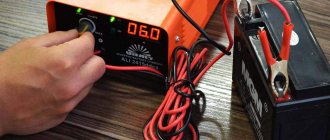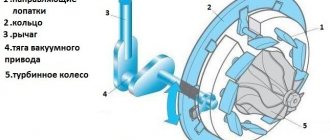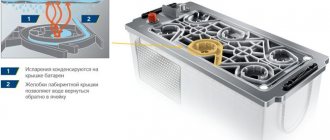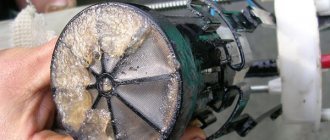What to do if the electrolyte is frozen
If in the morning you cannot open the car door or the engine does not start, then the battery is dead. In frosty weather this occurs due to freezing of the electrolyte. Signs of a frozen battery: swollen case walls and a layer of frost. To prevent the battery from freezing:
- Do not leave it in a discharged state for more than 24 hours in the cold;
- Check it for current leakage in the circuit;
- Do not let your car sit for long periods of time in winter.
When the device freezes, the plates and separator may become deformed and cracks may appear, so such a battery cannot be immediately connected to charging. To deal with the problem, follow the plan:
- Remove the battery;
- Inspect it for cracks and other damage;
- Place the device in an enamel bowl and wait until the ice melts and the body returns to its normal shape.
- If you do not find any deformation, charge the battery according to a special schedule.
First, use litmus paper to check whether the moisture on the case is harmless. A small amount of electrolyte may leak through microcracks that are not visible to the eye. If the indicator strip does not turn red, then everything is in order.
Do not place a frozen battery in hot water. If you need to defrost the charger as quickly as possible, immerse it in cold water and gradually increase the temperature or use a heat gun.
What not to do if the battery is frozen
If such a situation does occur, it is important to know what you should not do so that attempts to defrost the liquid do not lead to battery damage.
Try to charge the battery (do not charge the battery until it warms up - this may lead to a short circuit).
Defrosting with improvised means (the use of various heaters can lead to cracks in plastic and metal, which will cause leakage.).
Take out the electrolyte (you won’t be able to get all the electrolyte out anyway, but you can damage the case).
Adding electrolyte (firstly, it is not recommended to do this until complete frostbite, and secondly, it simply does not make sense).
Can the electrolyte freeze completely?
The freezing point of solutions of salts and acids depends on the concentration and composition. In a battery, the electrolyte includes sulfuric acid. The lower the acid concentration, the higher the freezing point. For example, with a density of 1.14 g/cm3. the solution will freeze at -11 degrees. And if the density is 1.25 g/cm3. The electrolyte will freeze completely only at -50. If the battery is discharged, the sulfuric acid can turn into a piece of ice. In this case, the battery will become severely deformed and will no longer work.
Causes of freezing
Drivers with little experience often ignore environmental conditions that can negatively affect the condition of the car or its individual components. As a result, a frozen battery may appear in the car.
The main reason why this happens lies in the state of the electrolyte. In fact, this liquid contains a high water content and a small percentage of acid. During the discharge process, lead sulfate crystals form on the lead plates.
Such a chemical reaction stimulates a decrease in the percentage concentration of acid in the solution. The result is the following processes:
- battery charge drop;
- decrease in electrolyte density;
- increased risk of liquid freezing.
The final stage of undesirable events is the transition of the electrolyte to plain water. When the density reaches critical values close to 1.1 g/ml, there is a risk of crystallization of such a composition even at sub-zero temperatures.
It is important to know that in modern well-charged batteries the electrolyte density is 1.2–1.22 g/ml.
Traveling by car helps to gradually discharge/charge the battery level. This is influenced by turning on and off peripheral power consumers. In winter, electricity is removed from the generator, which should be used to charge the battery, by a heater. Accordingly, in cold weather the battery runs the risk of freezing.
Why does the battery freeze?
The action of any battery is based on a redox reaction. When the device discharges, a lead sulfate residue forms. This way the concentration of sulfuric acid decreases and conditions for freezing of the electrolyte appear. To avoid this, some car owners buy a new battery for the winter. Others prefer to use disposable calcium batteries. It is impossible to check the state of the electrolytic solution in them, so control is carried out using open circuit voltage. Keep in mind that the battery freezes if the operating conditions are violated, that is, the electrolyte concentration has dropped below the point of crystal formation. At the lowest concentration, the battery freezes at -7 degrees, so this process is only possible in winter.
How should you look after your car battery?
To increase the service life of the battery, it is necessary to monitor its condition by checking the electrolyte density, its level and charging before changing seasons.
This is especially true before the onset of cold weather.
But, despite periodic scheduled battery maintenance, any battery can be discharged in the cold. It all depends on air humidity and air temperature. In order not to find yourself in a difficult situation associated with a discharged battery, each owner must purchase an electric charger, with the help of which any car owner can independently charge a discharged battery. In addition, each of us must purchase a device for measuring battery density.
In winter, after starting the engine, we advise you not to turn off the engine for as long as possible so that the car’s generator can restore the battery charge, which has become lower after the starter consumes the energy necessary to start the engine.
Remember that the lower the ambient temperature, the faster the battery loses stored energy. This means that if you haven’t started the car for several days in the cold, the battery may be completely discharged when you start the engine. Therefore, when starting the engine in winter, let it run for at least 30-40 minutes so that the battery charge is fully restored.
How to charge a frozen battery
If the battery has thawed and you have not found any cracks or deformations on it, you can charge it. To do this, it is recommended to use an automatic charger. First, the ASU applies a pulsed current, due to which sediment is removed from the plates. Then 5% of the charging current of the total capacity is supplied. That is, a 60A battery will be recharged with a current of 3A. This charging lasts for 8-10 hours with a gradual decrease in current strength. Do not overcharge a defrosted battery.
Experts also recommend checking the transparency of the electrolyte. If it is cloudy, there may be a short circuit. This indicates that the plates are crumbling, which means the battery is out of order.
Measuring the density of electrolyte in a battery
Measuring the density of the electrolyte poured into a lead battery is not so difficult, however, there are certain nuances associated with the features of the device and the principle of operation of the battery. Here are some important points to consider:
- It is possible to carry out the procedure for measuring density only in the case of a so-called serviceable battery, which provides access to banks (sections) with electrolyte through filler holes closed with lids. It is through these holes (usually their number is six, as is the number of sections) that the composition is taken to measure the density.
- During its operation, a car battery is constantly charged and discharged. The discharge occurs when the starter is cranked, and the charge occurs when the engine is already running from the generator. Depending on the degree of charge, the density of the electrolyte also changes. Values can vary between 0.15-0.16 g/cm3. It is important to note that a car alternator is not capable of fully charging the battery. During normal operation of the car, only 80-90% of the battery's potential is used. A full charge can only be provided by an external charger, which must be used before measuring the electrolyte density.
- The density of the electrolyte depends on its temperature. Usually measurements are made at a temperature of +25 °C, otherwise corrections are made.
Let's assume that all the above conditions are taken into account, and it is possible to proceed directly to measuring density. To do this, you will need a special device - a densimeter, which consists of a hydrometer, a rubber bulb and a glass tube with a tip. The device is inserted into the battery jar through the filler hole, and then the electrolyte is sucked in using a rubber bulb. This continues until the hydrometer floats to the surface. The readings are taken after the hydrometer stops oscillating and it becomes possible to determine the exact value. The readings are taken on a scale, while the gaze should be at the level of the surface of the liquid.
The resulting value should be in the range of 1.25-1.27 g/cm3 if the car is operated in the middle zone. In a cold climate zone (the average monthly temperature in January is below -15 °C), the indicator should be in the range of 1.27-1.29 g/cm3. You need to check the electrolyte density for compliance with these numbers in each of the six battery cans. The readings should not differ by more than 0.01 g/cm3, otherwise they will need to be adjusted.
As we have already said, the density of the electrolyte changes depending on the temperature. This means that in winter and summer, the liquid in the same fully functional battery will have different densities. The table below gives an idea of how much the readings will vary.
| Electrolyte temperature, °C | Correction to densimeter reading, g/cm3 | Electrolyte temperature, °C | Correction to densimeter reading, g/cm3 |
| -55…-41 | -0.05 | +5…+19 | -0.01 |
| -40…-26 | -0.04 | +20…+30 | 0 |
| -25…-11 | -0.03 | +31…+45 | +0.01 |
| -10…+4 | -0.02 | +46…+60 | +0.02 |
The dependence of the freezing temperature of the electrolyte on its density is shown in another table. Based on these data, it is possible to establish the optimal electrolyte density for specific climatic conditions. The lower limit of the selected interval should ensure that the electrolyte does not freeze even in the most extreme cold and will provide the force required to crank the starter. At the same time, it is also impossible to overestimate the density, since corrosion processes begin to accelerate on the positive electrodes of the battery, leading to sulfation of the plates.
| Electrolyte density at 25 °C, g/cm3 | Freezing temperature, °C | Electrolyte density at 25 °C, g/cm3 | Freezing temperature, °C |
| 1.09 | -7 | 1.22 | -40 |
| 1.10 | -8 | 1.23 | -42 |
| 1.11 | -9 | 1.24 | -50 |
| 1.12 | -10 | 1.25 | -54 |
| 1.13 | -12 | 1.26 | -58 |
| 1.14 | -14 | 1.27 | -68 |
| 1.15 | -16 | 1.28 | -74 |
| 1.16 | -18 | 1.29 | -68 |
| 1.17 | -20 | 1.30 | -66 |
| 1.18 | -22 | 1.31 | -64 |
| 1.19 | -25 | 1.32 | -57 |
| 1.20 | -28 | 1.33 | -54 |
| 1.21 | -34 | 1.40 | -37 |
Preventive measures
One way to prevent freezing is to insulate the battery.
This is especially useful for cars with low mileage and long-term parking. Also, during the cold season, use an electrolyte with a higher density. It freezes at lower temperatures. Checking for leaks in the on-board system and the functionality of the generator will help you be confident in the performance of your battery. And for a new battery, go to Delmex!
How to increase electrolyte density
You can lower or increase the density of the electrolyte in the battery by pumping out a certain amount of it and replacing it with distilled water or an electrolyte with a higher density (correction). This procedure requires a lot of time, since the pumping-topping cycle can be repeated several times until the required value is reached. After each adjustment, you need to charge the battery (at least 30 minutes), and then let it stand (0.5-2 hours). These actions are necessary to better mix the electrolyte and equalize the density in the jars.
In the process of increasing (or decreasing) the density of the electrolyte, do not forget about monitoring its level. It is carried out by a glass tube with two holes at the edges. One edge is immersed in the electrolyte until it hits the safety mesh. Next, the upper end is closed with a finger, and the tube itself is carefully lifted along with the column of liquid inside. The height of this column indicates the distance from the top edge of the plates to the surface of the poured electrolyte. It should be 10-15 mm. If the battery has an indicator (tube) or a transparent case with minimum and maximum marks, then monitoring the level is much easier.
Do not forget that all operations with electrolyte must be performed carefully, using protective gloves and goggles.











